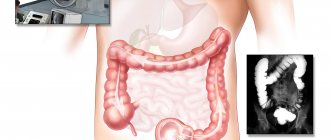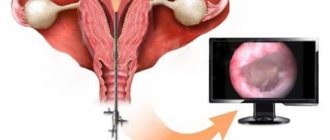The intestinal canal is responsible for the digestion of food and the state of the immune system. In order to promptly detect problems in the functioning of the organ, you need to undergo an annual examination. One such technique is intestinal colonoscopy.
What is an intestinal colonoscopy? This concept means carrying out a diagnostic procedure, during which the intestinal walls and mucous membrane are examined from the inside. Thanks to such manipulations, various pathological processes can be identified.
The colonoscope captures the image on a video monitor for your doctor to view. This also allows the doctor to remove a small amount of tissue for examination later. Doctors use colonoscopy to find the cause of colorectal problems. It is also used to screen for colorectal cancer in people who do not have symptoms.
Typically, a gastroenterologist performs a colonoscopy with the assistance of a nurse. This is usually done in a doctor's office or hospital. A gastroenterologist is a doctor who focuses on the function and diseases of the gastrointestinal tract. The surgeon may also perform a colonoscopy.
The technique is carried out using a special device called a colonoscope. This is a tube whose length is one and a half meters. At the end of the device there is an eyepiece, LEDs and a camera. When the internal examination begins, an image is displayed on the computer screen. Also, using a colonoscope, you can take material for histological examination.
Preparing for a colonoscopy
When you schedule an exam, your doctor will give you detailed instructions on how to prepare. Discuss any drug allergies or medical conditions you have. You will need to avoid solid foods and drink only clear liquids one to three days before the procedure. A liquid diet may include foods such as protein broth or broth, black coffee, deformed fruit juice, or gelatin. You will also need to take a laxative or give yourself an enema the day or night before your colonoscopy to empty your colon. If your doctor prescribes a laxative, it will be a pill or powder that you mix with water before drinking. After the procedure, you will be lethargic from the sedative. Leading up to the time, arrange for a friend or family member to drive you home. Check your insurance coverage to see if it includes the facility where you will get the test, the doctor who will perform the colonoscopy, and the anesthesiologist who will give the sedation. You will be asked to sign a consent form in which you understand the risks and benefits of a colonoscopy and agree to the test. Talk to your doctor about any problems you have with a colonoscopy. When you arrive for your colonoscopy, you will remove your clothing and change into a hospital gown. You will then find yourself on the side of an examination table in a private room with a sheet placed over your body. The nurse will give you pain relief and a sedative through an intravenous line. The doctor inserts a colonoscope and blows air into the colon. This will inflate it so the doctor can better see the colorectal lining. As your doctor guides the colonoscope through the curves of your colon, you may need to adjust your position slightly to allow better access. If there is an abnormal growth or polyp in your colon, your doctor will use an instrument at the end of the colonoscope to remove it or perform a biopsy. This usually does not cause pain. But bleeding may occur in the area where the tissue is removed. The doctor can stop the bleeding using a colonoscope.
- Tell your doctor about the medications you take.
- Be sure to ask if they should take them on the day of the test.
- During a colonoscopy, the colon should be empty.
- It is inserted into a vein in the arm.
- You may feel a slight sting as he or she inserts the needle.
The procedure usually takes from 30 to 60 minutes.
Features of intestinal colonoscopy
Colonoscopy of the intestine is a modern examination technique. Thanks to her you can:
- assess the condition of the mucous membrane, motility of the digestive organ and identify the presence of inflammatory processes;
- clarify the diameter of the intestinal canal and, if necessary, expand it due to scar tissue;
- recognize even the slightest changes in the intestinal walls, various pathological formations in the form of cracks, polyps, hemorrhoids, ulcers, diverticula, tumors and foreign bodies;
- remove any foreign bodies you see and take a small piece of mucous membrane for examination;
- remove small benign formations. This process will avoid surgical intervention;
- recognize the causes of intestinal bleeding and eliminate them using the thermocoagulation method.
The procedure can be performed in any public or private clinic. It is recommended for people over 40-45 years old, as well as for those who have complaints of abdominal pain, nausea, constipation or diarrhea.
In general, the pain medication and sedative you receive before your colonoscopy should limit the discomfort you may feel. You may also feel discomfort from lying down for long periods of time. If you feel cramping, taking slow, deep breaths can help relieve the pain.
Rarely, a colonoscope may puncture the wall of the colon, and surgery may be required to repair the hole. Talk to your doctor if you have concerns about this small risk. You will remain at the facility where you had your procedure for up to 2 hours. You must wait until the effects of the sedative wear off. If you receive anesthesia or sedation, you should not drive, operate a machine, or make critical decisions for the rest of the day.
Indications for bowel examination
Who is indicated for colonoscopy of the large intestine? Examination of the digestive tract using this technique is prescribed:
- when complaining of pain in the abdominal area;
- in the presence of discharge from the rectum in the form of mucus or pus;
- with bleeding from the intestinal tract;
- in case of intestinal motility disorders;
- with weight loss, development of anemia, low-grade fever, presence of cancer;
- when a foreign body enters the intestinal canal;
- when identifying benign formations.
Also, colonoscopy of the large intestine is prescribed for suspected intestinal obstruction, Crohn's disease, ulcerative colitis and malignant tumors. This diagnostic method helps to detect various diseases of the mucous membrane and take material for histology.
A friend or family member can drive you home. You can expect to resume your normal activities the day after your colonoscopy. Contact your doctor immediately if you have. Severe abdominal pain Bloodthirsty bowel movements. . Before your colonoscopy, ask your doctor to answer the following questions.
Why are you recommending a colonoscopy for me? What happens if I fail this exam? Who will perform the colonoscopy? What will happen during the test? How long will the procedure take? What are the risks and benefits of a colonoscopy? Should I avoid any activities after a colonoscopy?
Restrictions on bowel examination
A colonoscopy of the rectum is an excellent way to identify various problems that occur in the digestive tract. But there are a number of restrictions such as:
- infectious processes of an acute nature, which are characterized by an increase in temperature, poisoning of the body and weakness;
- pathological processes in the cardiovascular system. This includes heart failure, myocardial infarction, the presence of artificial valves;
- a sharp drop in pressure;
- pulmonary insufficiency;
- peritonitis, perforation of intestinal walls;
- diverticulitis;
- acute inflammatory processes in the presence of ulcerative colitis;
- severe intestinal bleeding;
- umbilical and inguinal hernia;
- pregnancy;
- pathological processes that lead to blood clotting disorders.
The above conditions increase the risk of side effects. Therefore, this technique is being replaced by other types of research. It is worth noting that rectal colonoscopy has nothing in common with colposcopy. The second type of study involves taking material from the cervix of women.
What procedures can be performed during a colonoscopy?
Who will explain the results to me? But what type of colorectal cancer screening test should you get? Many people choose colonoscopy, the gold standard for colorectal cancer screening and prevention. But there is another option - a virtual colonoscopy.
What diseases can a colonoscopy detect?
Colonoscopy: recommended every 10 years. During a colonoscopy, your doctor will use a flexible tube to insert a tiny camera into your colon through your rectum. They will look for polyps or other problems when the tube is removed. Polyps are small growths on the wall of the colon. If left untreated, they can grow and develop into cancer over time.
Preparing for intestinal colonoscopy
How is the intestinal colonoscopy procedure performed and what is needed to prepare for the examination? In fact, it occupies one of the important places. The better the patient prepares for the manipulation, the better and more truthful the result will be.
Minor discomfort—Your doctor may give you medication to help you stay relaxed and comfortable during the exam. Complications - This is not common, but insertion of the area can cause bleeding and tearing of the colon. Polyp removal – Your doctor may remove polyps during a colonoscopy. . Virtual colonoscopy: recommended every five years.
These images show polyps and other abnormalities inside your colon and rectum. Fewer complications - You won't have to worry about bleeding or rupture of your colon. If your doctor sees a polyp or something else unusual during your virtual colonoscopy, you will need to get a traditional colonoscopy to remove the polyp or perform a biopsy. Radiation Exposure – A virtual colonoscopy exposes you to a low dose of radiation.
- Less invasive—your doctor inserts a tube into your rectum and colon.
- But it will be shorter than the tube used for a colonoscopy.
- In more detail, your doctor may be able to see the area outside the colon.
- This allows other problems in the pelvic area to be identified.
- Follow-up colonoscopy.
If you're leaning toward a virtual colonoscopy so you can skip prep for a colon cleanse, think again.
Preparatory measures are based on compliance with a special diet and high-quality cleansing of the large intestine.
Following a specialized diet
A proper diet will free the intestinal walls from toxins and remove fecal stones. Preparatory measures should begin two to three days before the procedure.
Both tests require a clean colon. This means that you may only have clear liquids the day before the test and you will have to take a lot of laxative solution. No screening exam is 100% accurate. Your doctor may not find every polyp during your exam. This is especially true for polyps that are more difficult to detect, such as small or flat polyps.
What is a colonoscopy of the rectum?
But, research shows that both exams are good options for screening for and preventing colorectal cancer. The cost and coverage of screening exams varies. Before scheduling an exam, ask your insurance company if the exam will be covered.
Products in the form of:
- fruit and vegetable crops;
- greenery;
- berries, legumes and nuts;
- fatty meat, fish and sausages;
- porridge You cannot eat oatmeal, pearl barley and millet porridge;
- pasta;
- carbonated drinks;
- black bread;
- whole milk and coffee.
All of the above dishes are poorly absorbed by the body, which leads to increased gas formation.
Start a discussion about colorectal screening at your next checkup. If you are, talk to your doctor to find out when you should be screened. Regardless of what you choose, don't put off this test for fear of discomfort.
How is the procedure done?
Information provided by the American Gastroenterological Association. The term colonoscopy means looking inside the colon. This is a procedure performed by a gastroenterologist, a highly trained specialist. It begins with the cecum, which is attached to the end of the small intestine, and ends at the rectum and anus. The colon is a hollow tube about five feet long and its main function is to store unabsorbed food until it is eliminated.
Before the procedure, the patient is allowed to eat:
- wheat bread;
- boiled lean meat in the form of beef, chicken;
- fish in the form of pink salmon;
- vegetable-based broths;
- dry cookies in the form of biscuits;
- fermented milk products in the form of kefir, curdled milk, yogurt.
The last meal should be the day before at twelve o'clock in the afternoon.
Over the next 24 hours, you can only drink water or tea.
The main instrument used to look inside the colon is a colonoscope, which is a long, thin, flexible tube with a tiny video camera and a light at the end. By adjusting the various controls on the colonoscope, the gastroenterologist can carefully guide the instrument in any direction to look at the inside of the colon.
Colonoscopy is more accurate than x-rays. This procedure also allows other instruments to be passed through the colonoscope. They can be used, for example, to painlessly remove a suspicious growth or to take a biopsy - a small piece for further analysis. Thus, a colonoscopy may help avoid surgery or better determine what type of surgery may be needed.
Colon cleansing
Colonoscopy of the rectum and large intestine involves mediocre cleaning. It is performed using laxatives or enemas.
If cleansing is done with an enema, then the night before you need to give two enemas. To do this you will need an Esmarch mug and two liters of water.
A shorter version of a colonoscope is called a sigmoidoscope, an instrument used to screen the lower part of the colon. A colonoscope, however, is long enough to look at the entire colon and even part of the small intestine. Colonoscopy is a safe and effective way to evaluate problems such as blood loss, pain and changes in bowel habits such as chronic diarrhea or abnormalities that may be first detected by other tests. Colonoscopy can also identify and treat active bleeding from the intestine.
If laxatives are preferred, they are taken little by little throughout the day. Fortrans is most often prescribed, since it does not lead to disruption of the water-salt balance. About three to four liters of solution should be consumed per day, depending on the patient’s weight.
Colonoscopy is also an important way to check for colon cancer and treat colon polyps, which are abnormal growths on the inner lining of the intestine. Polyps vary in size and shape, and while most are not cancerous, some can develop into cancer. However, it is impossible to tell just by looking at a polyp if it is cancerous or potentially cancerous. This is why colonoscopy is often used to remove polyps, a technique called polyectomy.
How to prepare for the procedure?
There are important steps you should take to prepare for the procedure. First, be prepared to provide a complete list of all medications you take, as well as any allergies you have to medications or other substances. Your healthcare team will also want to know if you have any other medical conditions that may require special attention before, during, or after your colonoscopy.
How is an intestinal colonoscopy performed? This type of manipulation frightens patients, because during the procedure a special tube is inserted into the intestinal canal.
The execution scheme is as follows.
- The patient lies on the couch on his left side. The legs are bent at the knees and pressed towards the stomach.
- The doctor treats the anus with an antiseptic and carefully inserts the tube.
- If the patient has increased sensitivity, then before performing the manipulations, anesthetic drugs in the form of gels are used.
- After this, the doctor slowly and carefully moves the device further. Meanwhile, the intestinal walls are examined, and the image is displayed on the monitor.
- To straighten the folds near the intestines, air is supplied from the tube.
The duration of the procedure is about 15-20 minutes. If a colonoscopy is performed as a therapeutic or diagnostic procedure, the duration may increase to 30-40 minutes.
Possible complications of colonoscopy
During the examination, air is pumped into the rectum. At the end of the procedure, it is suctioned back. But at this time the patient may feel an unpleasant bursting feeling. To avoid this phenomenon, doctors advise taking activated charcoal. To do this, it must first be dissolved in water.
A colonoscopy of the colon should be done in a specialized institution where only experienced doctors work. It is best if it is a public clinic. If all recommendations are followed, then everything will go without complications, and the technique will be harmless.
In rare cases, a number of complications occur during colonoscopy, such as:
- perforation of the intestinal walls. The mucous membrane is damaged, as a result of which a purulent process can begin. Then the patient urgently undergoes surgery to restore the damaged tissue;
- bleeding from the rectum. It can also appear due to damage to the mucous membrane or blood vessels. Eliminated by cauterization or injection of adrenaline;
- painful sensations in the abdominal area. Most often it manifests itself against the background of removal of benign formations. You can eliminate the unpleasant feeling with the help of antispasmodics or analgesics.
If adverse complications develop, the patient should urgently consult a doctor. This is especially important if the symptoms are accompanied by nausea, vomiting, dizziness and weakness. Other unpleasant consequences may also occur in the form of loss of consciousness, diarrhea with blood, and vomiting of feces. Then an urgent call for an ambulance is required.
Rectoscopy is an effective diagnosis of the rectum
Modern proctology uses examination of the rectum using a proctoscope for diagnosis, treatment, and prevention of a number of pathological conditions of this organ.
The rectum is the final part of the human digestive tract, into which food remains that are not absorbed into the small intestine, along with water, pass. Its function is to ferment them and form feces. The rectum ends with the anus, through which they are excreted. In addition, the procedure allows you to examine part of the sigmoid colon, namely its distal sections, which pass into the rectum.
The rectoscope, which is used during the procedure, is equipped not only with lighting, but also with an air supply system. Thanks to it, the endoscopist can inflate the intestinal cavity and get an overview of the diagnosed areas and parts of the organ.
The procedure is effective for identifying neoplasms of a benign or malignant nature at different stages of their development. It allows you to obtain data on the state of the anatomical structure down to a level of 25 cm from the anus. Sigmoidoscopy with biopsy makes it possible to obtain tissue samples for histological studies and clarify the diagnosis. It has minimal contraindications and, when performed correctly, is characterized by minimal discomfort, which allows you to avoid the use of anesthesia.
Alternative methods for examining the intestines
If for some reason the patient has contraindications, then you can choose a different examination technique. These include:
- sigmoidoscopy. A small device called a sigmoidoscope is used, which is inserted into the rectum to a depth of 30 centimeters;
- irrigoscopy. This method of research involves the use of x-rays with a contrast agent;
- channel. This is a modern method that does not require the insertion of tubes into the digestive tract. A scanner is used for research, so manipulations are considered gentle and harmless.
The doctor will tell you which method is best to choose based on the indications and limitations.
Colonoscopy is one of the leading methods for examining the rectum in proctology. With its help, dangerous diseases that pose a threat to the health and life of the patient are identified, and some of them are treated.
Despite certain difficulties in its implementation, with proper preparation of the patient and the competence of the doctor, it is a fairly safe and painless procedure, the implementation of which is recommended for all people over 45 years of age, provided there are no contraindications.
This helps to identify deviations from the norm in time and carry out timely therapy.
How endoscopic research methods developed
Instrumental methods for diagnosing diseases of the large intestine developed gradually.
In the early stages, their capabilities were limited.
The invention of the rectosigmoidoscope made it possible to examine the patient's rectum, but did not make it possible to move further, because the device was distinguished by its rigidity.
In some cases, radiography helped, but it did not show oncological processes and polyps on the intestinal walls. Doctors had to examine him surgically through small incisions on the patient's body, which often led to the development of complications.
The invention of the sigmoid camera in the early seventies, capable of moving along a special conductor in the patient’s body, made it possible to examine the entire intestine, but blind photographs of such an extended area were uninformative.
In the mid-seventies, a fiber colonoscope with a flexible end was invented. This was a breakthrough in endoscopy and allowed the doctor to go beyond previously available capabilities.
The development of a colonoscope model, which made it possible not only to examine the surface of the mucous membrane, but also to record images in photographs, significantly improved the technique. If we take into account the fact that during the procedure it became possible to take part of the biological material for analysis, then significant progress has been observed in the field of diagnosing diseases of the large intestine. With proper preparation of the patient's body, which consisted of a special waste-free diet and the use of laxatives and enemas to cleanse the intestines, colonoscopy made it possible to qualitatively examine the inner surface of the intestine.
What is a colonoscopy and what equipment is used to perform it?
To examine the intestines using colonoscopy, an optical probe or fiber colonoscope is used. Due to the flexibility of the device, it can pass all anatomical curves of the intestine almost painlessly. With its help, not only a diagnostic study is carried out, but also a biopsy and removal of polyps.
This procedure uses a transmitting device that is inserted through the anus. It is equipped with a backlight to improve visibility inside the intestines. The image obtained as a result of the examination is recorded. If necessary, the doctor can review it again.
Advantages of the method
The importance of colonoscopy as a method for diagnosing diseases of the large intestine cannot be overestimated. It is more effective than conducting a virtual examination (MRI), since its reliability is estimated to be no more than 80%. If deviations from the norm are detected, it will still be necessary to conduct an instrumental study to make an accurate diagnosis, and in some cases, eliminate them.
Colonoscopy allows you to find polyps, which over time can narrow the intestinal lumen, even to the point of stenosis, and also, under unfavorable circumstances, degenerate into oncological formations.
Modern technology allows, when they are detected, to immediately remove and take part of the biological material for histological examination. Another advantage of colonoscopy is the possibility of local anesthesia; general anesthesia is prescribed only in exceptional cases, or at the request of the patient.
Unlike rectoscopy, in which the doctor examines a section of the intestine that does not exceed 30 centimeters in length, using colonoscopy you can obtain information about the condition of a much larger section of the intestine.
Advantages of sigmoidoscopy at Doctor Nearby clinics
Specialists from Doctor Nearby clinics will help eliminate the risk of complications and discomfort during the procedure. They have modern rectoscopes and effective painkillers, which can be used if the patient has indications.
They have carried out this procedure several times, so they are well familiar with all its features and nuances. If you want to be sure that sigmoidoscopy will be performed correctly and safely, contact us!
You can find out the cost of the procedure in the price list in this section of our official website!
Colonoscopy of the intestine: indications, contraindications and side effects
The health of the human body depends on the proper functioning of all organs and systems. Medicine is constantly developing and improving methods for diagnosing diseases that may occur in a patient, including pathologies of the large intestine.
Malfunctions in its functioning can lead to imbalance in the entire body, because it is responsible for performing such important functions as digesting food, absorbing nutrients and water, and excreting feces. Intestinal colonoscopy is a modern method for diagnosing colon pathologies that can lead to the development of serious complications.
Indications for testing
The large intestine performs an important task for the entire body, which is to digest, assimilate and eliminate food. With excessive stress and poor nutrition, its function may be impaired due to the development of pathological processes on its inner surface.
This may be expressed by the appearance of the following symptoms, which are indications for intestinal colonoscopy:
- The presence of constant and prolonged constipation.
- The appearance of abdominal pain of unknown etiology.
- Discharge from the rectum is both bloody and purulent.
- Significant weight loss for no apparent reason.
- Severe flatulence and bloating.
- Painful bowel movement.
Colonoscopy of the intestine is prescribed in preparation for some operations, and it is also mandatory for patients with suspected diseases of the large intestine.
Contraindications
To avoid damage to the colon, colonoscopy is not recommended for patients with the following conditions:
- Ulcerative colitis in the active stage
. With this disease of the colon, caused by the interaction of genetic and external factors, the integrity of the mucous membrane is compromised, which can lead to its perforation. - Crohn's disease
. It can affect any part of the intestine, including the area examined during colonoscopy, and is characterized by an inflammatory process, lymphadenitis with the formation of ulcers and scars. This granulomatous disease has a severe chronic course and is difficult to treat. - Presence of an umbilical or inguinal hernia
. - Pregnancy
in women in any trimester. - Problems with blood clotting
, as this procedure can cause bleeding. - Peritonitis
.
Possible complications of colonoscopy after examining the intestines using an endocolonoscope
In some cases, intestinal colonoscopy may cause undesirable consequences.
Disruption of normal intestinal motility and bloating, which is caused by the introduction of air into the intestinal lumen. This can be eliminated with the help of special drugs or a gas outlet tube.
Injury to the anus due to insufficiently careful insertion of the colonoscope. Unpleasant sensations are removed with the help of analgesics, and to heal the injured area, gels and ointments with anesthetics are prescribed. In most cases, the procedure is painless, although unpleasant for the patient.
Diarrhea and defecation disorders caused by the use of enemas and laxative powder in preparation for a colonoscopy, which goes away on its own. In some cases, the doctor prescribes medications to normalize stools and restore normal bowel function.
Pain and bleeding at the site of polyp removal. Another factor leading to complications is oncology, which disrupts the intestinal lumen and can contribute to its injury.
The most dangerous complication of intestinal colonoscopy is intestinal perforation. This phenomenon is very dangerous, especially if it is not detected in time by a doctor. The patient feels severe pain, which is very difficult to endure. If the intestines are poorly cleansed before a colonoscopy, feces can enter the peritoneum through the resulting hole and lead to inflammation.
In this case, an urgent operation is needed to close the resulting hole. In the case of medical negligence, when the damage is not detected in time, everything can end in resection of part of the intestine, installation of an ostomy, or even death.
The following factors can lead to intestinal perforation:
- Inexperience and low qualifications of the doctor.
- Dystrophic phenomena and thinning of the intestine.
- Poor cleaning of the rectum and intestines from feces.
- Excessive bowel activity.
Injury during colonoscopy usually occurs in the area of natural bends of the intestine, in the area of the hepatic and splenic angles. In this case, it is easy to damage nearby organs: the liver and spleen, which leads to severe blood loss and sometimes to the removal of the spleen. Therefore, an intestinal colonoscopy must be performed in a medical clinic, so that in case of complications, the necessary assistance can be provided immediately.
Carrying out colposcopy of the cervix
Cervical colposcopy is a virtually painless and fairly simple procedure for both the patient and the doctor, but the importance of it is difficult to overestimate. Colposcopy of the cervix is performed during a routine outpatient examination by a gynecologist.
The examination begins with the woman lying down on the gynecological chair in the usual way, as comfortable as possible for herself in order to be sufficiently relaxed and calm during the examination.
The patient’s state of relaxation is one of the necessities so that the doctor can comfortably insert a gynecological speculum into the vagina. A woman should not strain her perineal or abdominal muscles, as this complicates insertion of the speculum and can cause discomfort and pain. To relax, it is recommended to fold your arms across your chest and breathe deeply; in this case, inserting the speculum into the internal cavity of the vagina will be easy.
Using an expander, the gynecologist brings the cervix into a position that allows for examination and visual assessment of its condition. Without the use of additional equipment, a specialist can determine emerging pathologies of the vaginal mucosa and cervix.
You should know that examining the condition of the endometrium and vagina using a colposcope is much more accurate, while undoubtedly having greater clinical significance, since a colposcope is a device that provides multiple magnification, is equipped with a lighting device and looks like a microscope. Thanks to its powerful magnification, this device allows you to quite clearly examine and assess the condition of the vessels of the cervix.
The procedure for colposcopy of the cervix is an exclusively visual, non-contact examination, so a feeling of discomfort can only be present during the process of inserting and removing the speculum. And also, some patients may find the doctor’s touch with a gauze swab, which is necessary to cleanse the examined mucous surfaces of secretions, not very pleasant. And if it is necessary to conduct an extended colposcopy, it will also be necessary to treat the cervix with a solution to carry out the examination.
During the procedure, accompanying tests are always taken - a smear of urogenital secretions and a smear for cervical cytology. In this case, the test results, in combination with the results of colposcopy, provide the most complete picture of the condition of the female reproductive organs.
How a colonoscopy is done, why preparation for intestinal colonoscopy is so important
Proper preparation for intestinal colonoscopy is very important for successful examination. This will reduce the risk of complications and increase the information content of the procedure. The patient needs to approach it with all responsibility and strictly adhere to the doctor’s instructions, who will prescribe a special diet and take the necessary medications before the colonoscopy. Its result and safety depend on this.
Preparation for intestinal colonoscopy consists of measures that will help make the procedure easier for the doctor and the patient, and will also increase the information content of the study:
- Preliminary preparation involves the abolition of iron supplements, activated carbon and bismuth, as well as hormones and cardiac drugs.
- To prepare for the procedure, a slag-free diet is prescribed. They begin to adhere to it 3-4 days before the date of the colonoscopy. In this case, the following products are excluded from the diet: mushrooms, legumes, cereals and grain-containing products, some vegetables and fruits and berries, nuts, dairy products (except fermented milk), carbonated drinks, fatty meats and fish, canned food and sausage products, as well as smoked meats and pickles. The consumption of sweets is strictly limited to the permitted list. The day before the procedure, the consumption of clear broths and colorless liquids is allowed, the consumption of which ends 2 hours before the start of taking bowel cleansing drugs.
- Colon cleansing should be done with medications prescribed by the doctor, without enemas with petroleum jelly. Stimulant laxatives are usually prescribed. If the patient has prolonged constipation, then their dose is doubled or they are used in combination with osmotic-type agents. Bowel preparation is carried out using the drug Fortrans, or cleansing enemas and castor oil are used.
Carrying out the procedure in detail
Patients who are scheduled for testing are interested in how a colonoscopy is done and what they need to be prepared for when going to the clinic. As a rule, the procedure takes place in a separate room of the clinic, equipped with the necessary equipment. The patient undresses and lies down on the couch in the fetal position on his left side. The study takes place under local anesthesia, under the influence of drugs with lidocaine. This anesthesia is usually sufficient so that the patient does not experience much discomfort.
The colonoscope is carefully inserted by the doctor through the anus.
He controls its progress through the intestines, focusing on the camera’s indicators. To increase the lumen of the intestine and smooth out its folds, which simplifies diagnosis, gas is supplied into the intestine, which is felt by the patient as bloating.
Excess air is removed using the apparatus used for the study through a special channel. The advancement of the colonoscope in particularly difficult areas, where there are physiological bends of about 90 degrees, is controlled by the doctor and his assistant using palpation. Information about how a colonoscopy is performed will help the patient be aware of what is happening and reduce anxiety during the examination.
The duration of the procedure on average does not exceed half an hour. After this, the device is removed and sent for disinfection. These studies are documented by the doctor in the form of a protocol, in which he gives the patient the necessary recommendations and referral to a specialist of the appropriate profile.
Women should remember that colonoscopy is not performed during pregnancy. During menstruation, it is done only in exceptional cases; it is better to wait until the discharge ends. In case of chronic hemorrhoids, colonoscopy is not only not contraindicated, but will also help to more clearly see the clinical picture of the disease and determine the patient’s treatment strategy.
How is colposcopy done?
The procedure algorithm depends on the equipment of the gynecological clinic or office, as well as on the equipment. Modern colposcopes speed up manipulation and greatly facilitate the learning process.
Procedure step by step
Colposcopy consists of several sequential manipulations:
- Preliminary inspection . In a chair, the uterus and appendages are palpated, the structure and consistency of the cervical canal is studied.
- Antiseptic treatment . The external genitalia are treated with an antibacterial solution.
- Equipment installation . Dilators and gynecological speculums are inserted, a colposcope is installed on the contrary, and the backlight is turned on.
- Biopsy . Material is collected for study if necessary, but if pathology is identified, such an analysis is not carried out.
- Treatment of the cervix . The cervical canal is treated with saline to remove secretions.
- Treatment of the cervix with acetic acid . The solution promotes paleness of the mucous membranes (moderate pallor indicates the health of the mucous membranes, and pronounced pallor indicates pathology). An unhealthy acetowhite color is necessarily recorded in the conclusion.
It is also important for women to know that:
- The vinegar test is also necessary to assess punctuation and mosaic - the condition of abnormal vessels. Tests can be gentle or rough. The first is carried out for minor vascular changes. The second - when expressed. In pathology, there is no vasospasm in response to the acetic substance. Atypical vessels have the shape of a corkscrew, comma or wave.
- Next, the doctor performs a Schiller test . To do this, the cervix is treated with iodine. Healthy tissues are painted in a dark shade. If the mucous membranes are not stained, then an additional examination of the tissue is carried out under maximum magnification.
- The final stage of the study is the assessment of the transformation zone . The zone of conditional division between flat and columnar epithelium is considered transitional. Normally, such a zone is located on the surface of the cervical canal. Atypical localization may be associated not only with pathology, but also with pregnancy and long-term use of oral contraceptives.
Important ! For any suspicious areas, a targeted tissue biopsy is performed for further morphological study. Based on colposcopy, a decision can be made to conize the cervix - excision of pathological areas of the mucous membranes.
Colonoscopy of the rectum: what shows what diseases are diagnosed with its help
Colonoscopy of the rectum and other parts of the large intestine helps to examine the condition of the mucous membrane, find tumors if they are present, take biological material for research and carry out treatment in some cases. It is good if the patient is informed what a colonoscopy shows, so that he has no doubt about the need for the procedure if indicated.
Despite the presence of contraindications and the possibility of side effects, the benefits of this diagnostic method for maintaining human health cannot be overestimated.
Virtual diagnostic technologies cannot provide as accurate information as examination using a fiber colonoscope camera.
The patient’s immunity depends on the health of the large intestine, since it is formed in particular by the microbial flora in it. Over an area of about two meters, water, vitamins and amino acids are absorbed. Disorders in this organ can lead to a deficiency of substances important for the body and the development of various pathologies.
What does a colonoscopy normally reveal?
Despite the fact that colonoscopy of the rectum is unpleasant from a psychological point of view, its implementation helps to detect emerging diseases in a timely manner and treat them, which will help preserve the patient’s health, and sometimes even life.
Using rectal colonoscopy, all parts of the large intestine are examined for compliance with the following indicators:
- The color of the mucous membrane should normally be yellow or pink, distinguished by pallor. If the color changes, this indicates the presence of inflammation or erosion.
- The shine of the intestinal mucosa indicates a sufficient amount of mucus on its surface. The areas where pathology develops do not reflect light well.
- The surface of the intestine is almost smooth; the presence of unusual bulges and tubercles is a sign of the development of pathology.
- The vascular pattern also carries information about the condition of the intestine; it should look in a special way, and any changes in its pattern should be further studied.
- The overlays of the mucous membrane should be light, but if they are too dense and have a different color, this is a sign of possible pathology.
Absolute contraindications
Most often, colposcopy is prescribed in situations where the patient consults a specialist or arranges a home call from a gynecologist due to the occurrence of the following symptoms:
- bleeding that is not associated with menstruation;
- prolonged “pulling” pain in the lower abdomen;
- discomfort and bleeding during and after sexual intercourse;
- genital warts were found on the genitals;
- poor results on oncocytology.
contraindications to colposcopy may arise
, you need to consider what type of it will be used. So, if this is a simple colposcopy, then there are no absolute prohibitions on its implementation. After all, it goes through like a regular gynecological examination using a mirror. The only difference is that at a certain distance from the entrance to the vagina (10-15 cm) a colposcope will be installed - a special optical or video device with a powerful light source and the ability to change the optical magnification of the object being examined.
There is also an extended colposcopy, which, in addition to examination, involves conducting diagnostic tests. In this case, the gynecologist applies various substances to the epithelium, such as acetic acid solution or Lugol's solution, which make it possible to identify areas with abnormal cells. An absolute contraindication to such tests can only be allergic reactions or individual intolerance to acetic acid and iodine.
Useful information on the topic:
- Gynecology as a science of female diseases
- Consultation with a gynecologist
- How does an appointment with a gynecologist go?
- Female doctor
- Diagnosis of sexually transmitted infections in women
- Diagnosis of gynecological diseases
- Treatment of female diseases
- Pediatric gynecologist
- How is a gynecologist examined?
- Paid gynecologist










